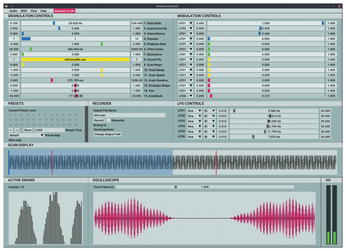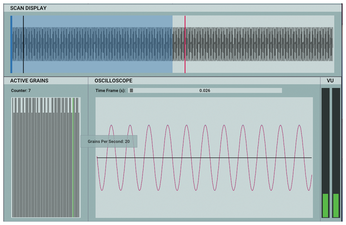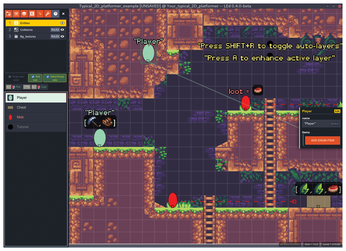FOSSPicks
EmissionControl2
Sound design is an unusual preoccupation. It's seldom used professionally, other than in niche gaming and movie-making scenarios, and even popular music most commonly uses pre-baked sound presets, sound libraries, and default loops from applications. With the exception of people like Brian Eno, the artists and musicians themselves will typically have done very little sound design. And yet, there are many of us with an innate fascination in the qualities of sound, who want to create unique sounding audio, regardless of whether it's destined for the avant garde or the garderobe. EmissionControl2, developed by a group calling themselves the Center for Research in Electronic Art Technology (CREATE), has been made for us.

EmissionControl has been around for a long time. The original version was PowerPC-only, running on a Mac, but version 2 marked a proper open source release and, subsequently, Linux builds alongside those for macOS. This is a great thing because EmissionControl2 is a slightly crazy and utterly unique sound generator for people who want to experiment with sound. It generates audio in real time from a series of audio files using something called granular synthesis. Granular synthesis is the audio equivalent of copying a group of closely positioned pixels in a video, mixing up their relative locations, changing their color, and blasting them onto a blank canvas. The output typically retains some flavor of the input audio files whilst generating something completely different. It can sound low-fi and gritty, with a seemingly low bitrate or sample rate, but it can also sound soft, organic, and evolving. You can play the sounds and control the UI from a MIDI controller, transposing grains without producing the same sampling artifacts you get with traditional samples. It's a sound that can't be created any other way.
The grains are taken in groups from one or more sound files at a specific "grain rate." The grain rate, like any of the other 14 different parameters, can be modulated by one of the six LFOs accessible on the right side of the UI. These six LFOs run independently of each other, between 0.01Hz and 30Hz (times a second), and they can be either sine, saw, or triangle waves, with noise for random variation. Parameters can control how the grains are panned and amplified, how they're picked up from the audio file, and the size of the window used to source them. Many of these parameters can be seen in an animated waveform preview of the audio file from which the grains are being taken. There's even a filter to change the sound, and all of this can be modulated. Beneath the waveform view, you get to visualize the resultant audio output in both an oscilloscope and an active grain counter. When you're happy with your configuration, you can save everything as a preset and then even morph between the parameters of two separate presets. Of course, none of this would matter if the resultant sound was awful, but it's not. It's both musical and unique at the same time, and while those of us fascinated by sound design will simply enjoy geeking out over the details, pop producers might find something they like even more than their synth presets.
Project Website
https://github.com/EmissionControl2

Level editor
LDtk
One of the best (proprietary) games of recent years is called Dead Cells. It's a beautifully, retro-themed sideways combat oriented platformer. What makes Dead Cells distinctive, besides the Rogue-like pseudo-random level generation, is that your player's character needs to die. A lot. This is because your reincarnated avatar inherits whatever buffs and power-ups you've previously been able to unlock, allowing you to break into new areas and, ultimately, the end game. This is all relevant because one of Dead Cells developers has distilled their experience into a new open source level editor that's been designed to help nascent game developers create the best possible levels for their games. The result is LDtk, a 2D map editor (formerly known as LEd) that hopes to make games designers out of us all.
First and foremost, LDtk attempts to be easy to use. You can drag your mouse across an empty canvas to paint the tiles for your own levels, and after creating a collision map, elements like grass and other textures are added automatically. There's some excellent documentation included within the application, as well as some well-designed example levels to help you through the main concepts. These concepts are mostly to do with the integer grid layers, tile layers, and entity layers, alongside your own definitions of enumerated types for the elements in your game, allowing you to link your graphical level design directly to your code. Levels are saved to a JSON-formatted file, which is very easy to understand and parse within your own games engine. While the editor has been designed to be platform agnostic, it's been written with the Haxe API and integrates wonderfully with the platform.
Project Website
https://github.com/deepnight/ldtk

Buy this article as PDF
(incl. VAT)
Buy Linux Magazine
Subscribe to our Linux Newsletters
Find Linux and Open Source Jobs
Subscribe to our ADMIN Newsletters
Support Our Work
Linux Magazine content is made possible with support from readers like you. Please consider contributing when you’ve found an article to be beneficial.

News
-
Ubuntu 24.04 Comes with a “Flaw"
If you're thinking you might want to upgrade from your current Ubuntu release to the latest, there's something you might want to consider before doing so.
-
Canonical Releases Ubuntu 24.04
After a brief pause because of the XZ vulnerability, Ubuntu 24.04 is now available for install.
-
Linux Servers Targeted by Akira Ransomware
A group of bad actors who have already extorted $42 million have their sights set on the Linux platform.
-
TUXEDO Computers Unveils Linux Laptop Featuring AMD Ryzen CPU
This latest release is the first laptop to include the new CPU from Ryzen and Linux preinstalled.
-
XZ Gets the All-Clear
The back door xz vulnerability has been officially reverted for Fedora 40 and versions 38 and 39 were never affected.
-
Canonical Collaborates with Qualcomm on New Venture
This new joint effort is geared toward bringing Ubuntu and Ubuntu Core to Qualcomm-powered devices.
-
Kodi 21.0 Open-Source Entertainment Hub Released
After a year of development, the award-winning Kodi cross-platform, media center software is now available with many new additions and improvements.
-
Linux Usage Increases in Two Key Areas
If market share is your thing, you'll be happy to know that Linux is on the rise in two areas that, if they keep climbing, could have serious meaning for Linux's future.
-
Vulnerability Discovered in xz Libraries
An urgent alert for Fedora 40 has been posted and users should pay attention.
-
Canonical Bumps LTS Support to 12 years
If you're worried that your Ubuntu LTS release won't be supported long enough to last, Canonical has a surprise for you in the form of 12 years of security coverage.

